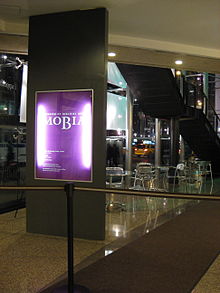- Museum of Biblical Art
-
The Museum of Biblical Art (MOBIA) is a museum in the United States dedicated to the exploration of the Bible's legacy in Jewish and Christian art. Originally the Gallery at the American Bible Society, the museum opened to the public as an independent entity on May 12, 2005 in a renovated space at 61st Street and Broadway in New York City.
The museum aims to become a nationally recognized centre of expertise on art and the Bible while maintaining a secular distance from its subject. Although it grew out of the American Bible Society, it is not a religious institution and takes no stand on religion itself. Rather, MOBIA hopes to open dialogue on a subject it considers under-explored, the influence of religion on art, while providing educational programs to visitors of every age and understanding.
MOBIA's director is Dr. Ena Heller. The museum is open Tuesday, Wednesday, Friday-Sunday from 10:00am - 6:00pm, and on Thursday from 10:00am - 8:00pm. The museum is closed on Mondays. There is a suggested donation of $7 for adults, $4 for students and seniors, and children under 12 are free.
Contents
Building
The Museum of Biblical Art is located at the corner of Broadway and 61st street, near Columbus Circle and Lincoln Center on the Upper West Side of Manhattan. The main 2,500-square-foot (230 m2) exhibition space was created after an extensive renovation, and the museum also includes an 1,100-square-foot (100 m2) education center for lectures, concerts, and children's activities. Principal architects Randall Goya and Sara Lopergolo, of G&L Architects of New York, also headed the Selldorf Architects design team on New York's Neue Galerie.
Exhibitions
The Museum of Biblical Art presents four exhibitions per year which highlight the changing relationship of faith, whether express, implied, or absent, to art.
MOBIA first welcomed visitors with the exhibition "Coming Home!: Self-taught Artists, the Bible, and the American South," featuring ninety-five works by seventy-three artists. The exhibit explored the way the Bible, in the context of evangelical Christianity, has influenced the subject matter, meaning and function of art made by Southern self-taught artists.
Later exhibitions included "The Next Generation: Contemporary Expressions of Faith," which dealt with contemporary religious art and artists in partnership with CIVA (Christians in the Visual Arts), and "Let There Be Light: Oil Lamps from the Holy Land," exploring the uses of clay oil lamps through history, on loan from the Bible Lands Museum Jerusalem.[1]
Currently on exhibit, "On Eagles' Wings: The King James Bible Turns 400" explores the tumultuous origins and dramatic impact of a literary masterpiece widely considered one of the most celebrated books in the English-speaking world. The exhibition explores the historic context in which the King James Bible was translated and published beginning with an examination of its predecessors, most notably the Bishop’s Bible sponsored by Queen Elizabeth I in 1568 and singled out as the model to which the translators commissioned by King James were to follow as closely as possible. The exhibition will present the touchstones of the translation process examining how this work was and continues to be inspirational for various audiences over time.
In October, MOBIA presents "The Land of Light and Promise: 50 Years Painting Jerusalem and Beyond, Ludwig Blum (1891-1974)." Known as the “Painter of Jerusalem,” Ludwig Blum (1891-1974) immigrated to Palestine in 1923 from what is now the Czech Republic. A veteran of the First World War and an academically-trained painter, Blum set about depicting the Middle East, most notably, the Holy Land, both through vast topographical scenes and through small-scale street and marketplace scenes. He portrayed Palestine, and later Israel, with an intimacy borne of his love for his adopted homeland and its people, and he painted Jewish, Christian, and Muslim sites alike, largely devoid of religious overtones.
Other upcoming exhibitions include "Walls Speak: The Narrative Art of Hildreth Meière," "Finding Comfort in Difficult Times: A Selection of Soldiers' Bibles" and "Louis C. Tiffany and the Art of Devotion."
See also
References
External links
Categories:- Biblical art
- Upper West Side
- Religious museums in New York
- Museums in Manhattan
- Art museums in New York
Wikimedia Foundation. 2010.

